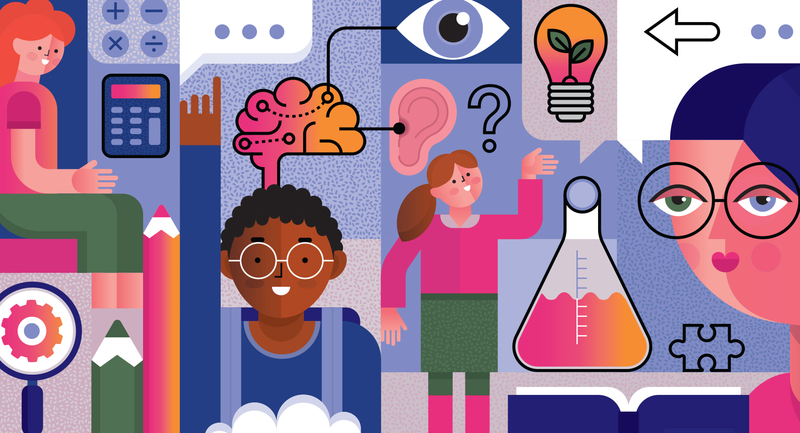A teacher assesses students' understanding of cause and effect by reading a new story but stopping before the conclusion. Students demonstrate that they understand logical relationships and consequences by drawing a cartoon story or by working with others in creating a dramatic presentation that explains what happened and why.
Another teacher has students use a Venn diagram to explain what the U.S. Civil War has in common with the Civil Rights struggle of the 1950s and '60s.
A primary grade teacher reads a four-stanza poem to her class but stops before the final stanza. Students then work in groups to show what they believe the last stanza will say. The teacher gives them several options, all requiring the use of multiple intelligences: They can create a song, dance, or picture to demonstrate what they believe is the ending, showing their understanding of the poem.
These are examples of what teachers and students at the New City School have been doing since 1988. New City School (an independent school) includes preschool through grade 6. For us, multiple intelligences is more than a theory of intellect; it is a philosophy of education with implications for how children can learn and how teachers can teach. Our work with multiple intelligences has affected how we design our curriculum, how we assess student progress, how we communicate with parents, and how we work together.
The Beginning
In spring 1988, a group of about 13 New School teachers and administrators began reading and discussing Gardner's Frames of Mind (1983). We met after school, before school, and during the summer. As we taught the chapters to one another and began incorporating the intelligences that we were covering in our teaching, it became clear to us that multiple intelligences could be a tool to help our students—and ourselves—grow. About one-third of our students are from minority groups, mostly African American, and we enroll students primarily from the central city of St. Louis. One-quarter of the students receive need-based financial aid.
Throughout our investigation, we were careful to keep the remainder of the faculty informed about our work. We tried to be as inclusive as possible, encouraging all faculty members to be a part of our learning. We consciously shared information with the entire faculty.
Today, a decade later, we are a different school. Though we always looked for our students' strengths, valued the arts, and emphasized personal development, the multiple intelligences framework has focused our efforts and given us a common vision.
Three Focus Areas—Plus
We changed our practices in three primary directions: curriculum development, student assessment, and communication with parents. Throughout our investigation, thinking and talking about multiple intelligences have also helped us create the kind of collegial environment that Barth (1990) advocates. We developed practices that work for us. But because the theory is neither an educational model nor a curriculum, faculty members at other schools can fashion practices to fit their own contexts. The range of applications is wide.
Curriculum development. A multiple intelligences approach recognizes and respects the different ways in which students learn. It gives them opportunities to use various intelligences to acquire knowledge and share what they have learned. How this is done varies by teacher, by subject, and by lesson. But there are some constants.
We expect students to learn to read, write, and compute well. We administer standardized tests each year on which our students perform far above grade level (as they should because they come from homes in which education is valued). But that is only a beginning. We also create ways for students to use their "other" intelligences (those other than linguistic and logical-mathematical) in learning. Each lesson does not reflect every intelligence; that is not a realistic expectation. As teachers plan their days, units, and themes, however, they work at incorporating different intelligences in their instruction.
In bringing the musical intelligence into a mathematics lesson, for example, an intermediate grade teacher uses rhythm instruments to help students understand fractions. Six students form a small circle, each with a different instrument, while the other students gather around—and then close their eyes. The teacher holds a sign showing a fraction to the children with instruments: 1/6, 2/6, 3/6, 4/6, 5/6, or 6/6. Depending on the fraction, the appropriate number of children in the circle make noise with their drum, tambourine, or shaker. The rest of the class has to rely on identifying the musical sounds to determine the fraction. Later two or more students can use the same musical instrument to illustrate 2/6 = 1/3 or 3/6 = 1/2.
A primary grade teacher uses the bodily-kinesthetic and musical intelligences to help children understand animal growth. The teacher assesses students' understanding of the frog's life cycle by having the children create and perform a frog ballet. Students are taught a few simple ballet moves (plié, pas de deux) to use in creating a dance to explain the growth and development of frogs. Students unfold and move to music, dancing to demonstrate the evolution from egg to tadpole to adult frog. The teacher videotapes the ballet, and students later critique themselves as a step in increasing intrapersonal intelligence.
Another teacher uses spatial and personal intelligences to teach children school and classroom rules. Students create a floor plan of the school, including the playground and lunchroom. Students create a key to indicate the "trouble spots," those areas where they, personally, are most likely to have difficulty following rules. Students share their plans with their classmates, discussing how they can avoid troublesome situations.
Many teachers bring the various intelligences into the classroom through learning centers. Teachers may let students choose the centers or, sometimes, assign students to work at a particular center so that they work in areas of both strengths and weaknesses. An intermediate grade teacher, for example, in helping students learn about the 50 states, has a bulletin board with varied activities listed under the seven intelligences. Students must proceed through all activities, so that they use all of their intelligences. They create hand-clap jingles to recognize the spelling of state names; they also complete word searches and do crossword puzzles. They work in teams to form the shapes of the states, and students stand on tables to photograph teams as they complete each state. (The photos are put in their student portfolios.) Students create illustrated journals, describing imaginary journeys through states. They make fact flash cards and, in some cases, create computer games for other students to use in learning about the states. Throughout these activities, they work individually and in groups.
Student assessment. In using multiple intelligences in the classroom, teachers vary assessment practices. No longer are standardized tests and paper-and-pencil exams adequate (if they ever were). Students need to show their understanding in a variety of ways, using various intelligences.
We have found portfolios to be extremely helpful in capturing students' performances. Each portfolio records student achievement on videotapes and audiotapes, and each includes an annual autobiographical entry (not necessarily a linguistic piece). Portfolios also contain at least one item reflecting student progress in each of the intelligences. At our spring Portfolio Night, children present the contents of their portfolios to their parents. Portfolios show parents that standardized tests and grades are not the only ways to validly measure their children's progress.
Our halls abound with students' projects and posters that demonstrate students' understanding through various intelligences. Displays have included three-dimensional Native American villages, cut-away representations of the Mayflower, and dioramas depicting scenes from the Revolutionary War. Other exhibits include illustrated book reports; bar graphs that compare students' skin color to foods (cocoa, oatmeal, bran flakes, cinnamon, graham crackers, or brown sugar); and student autobiographies done through graphs, not narratives. The library or auditorium foyer often hosts a "living museum" with students attired, posed, and performing as people they have studied. Other student-created museums display studies of plants or insects.
Communicating with parents. As we have changed how we teach and assess learning, so, too, have we changed how we report student progress to parents. Because we believe that the personal intelligences are the most important, the first page of our report card (fig. 1) is devoted to intrapersonal and interpersonal intelligences—confidence, motivation, problem solving, responsibility, effort and work habits, appreciation for diversity, and teamwork. Other pages of the report address the linguistic and logical-mathematical intelligences through a rubric-based format. Teachers check the appropriate level of mastery for each rubric (not yet, developing, achieving, or extending) and write narratives. On other pages, specialist teachers report on students' progress in musical, spatial, and bodily-kinesthetic intelligences.
Figure 1. Sample Items from 4th Grade Progress Report: The Personal Intelligences
For each grading period, teachers rate students on these and other items as follows: ED=Exceeding Developmental Expectations, DA=Developing Appropriately, AC=Area of Concern, #=Needs Added Attention
INTRAPERSONAL DEVELOPMENT. Can self-assess; understands and shares own feelings.
Is comfortable taking a position different from the peer group
Engages in appropriate risk-taking behaviors
Is comfortable in both leader and follower roles
Demonstrates internal motivation
Is actively involved in the learning process
Asks for help when needed
Can generate possible hypotheses and solutions
Accepts and learns from feedback
Accepts responsibility for own actions, practices self-control
Accepts responsibility for materials and belongings
V. Effort and Work Habits
Participates in activities and discussions
Works through assignments and activities carefully and thoroughly
Keeps notebook, desk, and locker/cubby organized
INTERPERSONAL DEVELOPMENT. Can successfully interact with others.
Appreciation for Diversity
Makes decisions based on appropriate information, rather than stereotypes
Respects the individuality of others
Cooperates with peers and adults
Works at conflict resolution
Behaves responsibly in groups
Copyright 1996 by the New City School, St. Louis, Missouri.
We begin the school year with a welcoming phone call to each family and with Open Houses. In late September, we hold Intake Conferences. Intentionally held too early in the year for us to be knowledgeable about our students, this is a time for us to hear from parents. They share their thoughts with us about how they view their children, including the particular intelligences that they see as strengths.
How and what we communicate with parents is extremely important. Because our school is quite different from the schools that most of our students' parents attended, we need to educate them about our multiple intelligences approach. We need their support. Every Friday all faculty members write letters to parents, discussing our curriculum and instruction, telling parents how we use multiple intelligences to help their children learn. We also put explanations by the hall displays so that parents will understand our goals.
Faculty collegiality. Because we believe that traditional approaches to instruction do not enable all students to realize their potential, we see multiple intelligences as a powerful tool. Bringing the theory into the classroom, however, changes the role of teachers. Our teachers are not just disseminators of skills and information but developers of curriculum and assessments. Our teachers are constantly reflecting on their efforts and making revisions. As a result, we attract—and support—teachers who are always looking for a better way to reach their students.
Multiple intelligences has become a tool to help our faculty work together, to learn from and with one another. Throughout our journey, we have created a new school, indeed. We developed new faculty committees to help us work together; we wrote two books (New City School 1994, 1996); and we hosted two multiple intelligences conferences. In all these efforts, our strong sense of collegiality has enabled us to move forward together. Because we view ourselves as learners, we are comfortable sharing and taking risks.
Challenges
Despite our gains, New City School is clearly a work in progress. As we look to the future, we know that we need to continue to work at using multiple intelligences to bring curriculum, instruction, and assessment together. Balancing alternative forms of assessment—portfolios, exhibitions, and performances—with standardized tests is an ongoing quest. And while our parents support our efforts, they still demand evidence that their children are achieving on traditional measures.
But perhaps our biggest challenge lies with keeping our faculty supported and challenged. Using multiple intelligences regularly requires an enormous investment of time and energy. Our kids and our teachers benefit, but we must be cognizant of the costs involved. As we continue to gain experience in using multiple intelligences, we hope to capitalize on our knowledge and reduce the demands that this approach places on our faculty. One thing we know is that the New City School of 2000 will be different from the New City School of 1997.







